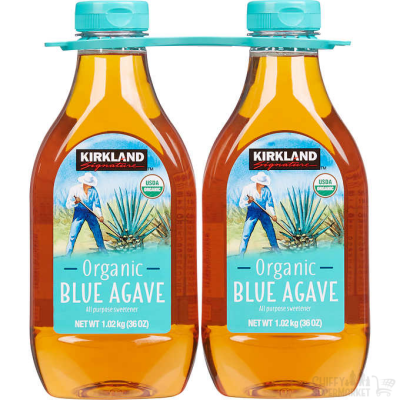
Kirkland Organic Blue Agave
This product is part of the Kirkland Signature (Costco) private label. It is an all-purpose sweetener weighing 72 ounces. It is offered in a 2-bottle case (32 oz each), made with Blue Agave and rated USDA Organic. It is classified as Gluten Free, Organic Syrup, which is used commonly in Vegan diets and as a sugar substitute. The product is backed by Kirkland’s satisfaction guarantee which allows a refund if you are not completely satisfied.
Nutritional Facts
Single Serving:
Calories: 60
Fat: 0g (0% DV)
Cholesterol: 0mg (0% DV)
Sodium: 0mg (0% DV)
Carbohydrates: 16g (32% DV)
Protein: 0g
The bottle contains only blue agave nectar with no added syrups or sugars.
Costco Agave
Costco offers their Kirkland Signature organic blue agave nectar. All prices for this product are from Costco and any updates should be verified via Costco. For information regarding delivery, please visit Costco’s Business Center Customer Service line by calling 800-788-9968.
Where does Agave come from?
Agave is found in a variety of countries, although it is most prevalent in Mexico, where it’s cultivated for tequila and other goods including agave syrup and agave inulin. While it does well at high altitudes and mineral-rich soils in the Mexican state of Jalisco, it may also be grown in various parts of Mexico.

What is Agave?
Agave is a succulent plant that belongs to the Agavaceae family (amaryllis). This plant, which creates agave syrup, also known as maguey syrup or agave nectar, is produced from several species of agaves, including Agave tequilana (blue agave) and Agave salmiana.
What are Agave Benefits?
You can feel confident about using agave syrup as a sweetener. It’s organic, non-GMO, gluten-free, and vegan! And it’s one and a half times as sweet as sugar, so you may save calories by using less to achieve the same levels of sweetness. Agave has a third fewer glycemic indexes than sugar.
Difference between Blue Agave and Agave
Agave nectar and blue agave nectar are both made from the agave plant, a succulent that thrives in hot, dry places all over the world. However, each variety of nectar comes from a distinct species of the agave plant. Blue Agave is generally cultivated from the Agave tequilana (Tequila Maguey for Mezcal) species in Mexico and is used to make tequila and mezcal. The plants are usually grown in the volcanic soils of the region, which give them their distinctive blue color.
Agave Species
Tequila Maguey
Mezcal is prepared from Tequila Maguey plant. This species of agave is used in certified mezcals and refers to its region.
Agave Tequilana
Agave tequilana, commonly referred to as blue agave (agave azul) or tequila agave and an important economic product of Jalisco, Mexico,
Agave Angustifolia
Agave Angustifolia is a species of agave plant that grows in Mexico and Central America. It’s used to produce mezcal as well as an ornamental plant, particularly the cultivar ‘Marginata.’
How is Agave Syrup Produced?
Organic blue agave is harvested by hand and then cooked in ovens or steam cookers. After cooking, the agave juice is extracted and fermented. The fermentation process can take up to two weeks, after which the tequila or mezcal is distilled.
Agave Uses?
Agave syrup is a low-glycemic sugar substitute that’s fantastic for beverages, sauces, syrups, baking, cocktails, and other applications. There are numerous different kinds available in many colors and degrees of intensity. Agave products have a smoky flavor to them. The lighter varieties have milder flavor profiles while the darker varieties taste more
Because agave syrup is so sweet (1.4 to 1.8 times sweeter than sugar), I would suggest using less of it when replacing sugar in cooking, baking, and other items. Here’s a quick rule of thumb when using agave to replace other sweeteners.
Substituting Agave for Sugar (Using Agave in Recipes)
- For white sugar, use three-fourths as much agave syrup as granulated sugar.
- For brown sugar, use three-fourths as much agave syrup as granulated sugar.
- For honey and maple syrup, use the same amount of agave as with honey.
- For corn syrup or rice syrup, substitute half of what you would use with agave (add a little water as needed).
Blue Agave Alcohol
Organic blue agave tequila and mezcal are made with 100% organic agave and are therefore considered to be more environmentally friendly than conventional varieties. They also tend to have a cleaner, smoother taste. Organic blue agave products are becoming increasingly popular, and are now available at many liquor stores.
Mezcal Clase Azul Guerrero 
Clase Azul Mezcal Guerrero (80 Proof) is one of Mexico’s best-kept secrets. It comes from the state of Guerrero, a little-known area that offers us a unique look at Mexican culture. The addition to the Clase Azul family was inspired by Guerrero’s natural beauty, cuisine, artistry, and history. This mezcal has been described as having crystal clear with light straw hues. An aroma of grapefruit, new wood, rosemary, peanut oil, and daisy.
Tres Agave Tequilla
Tres Agaves Blanco is an unaged and pure tequila that travels directly from Mexico. It’s the purest form of distiller’s art, capturing the clean, herbaceous flavor of real agave. Tress Agave is a family-owned distillery under the name of Tres Agaves Products Inc.